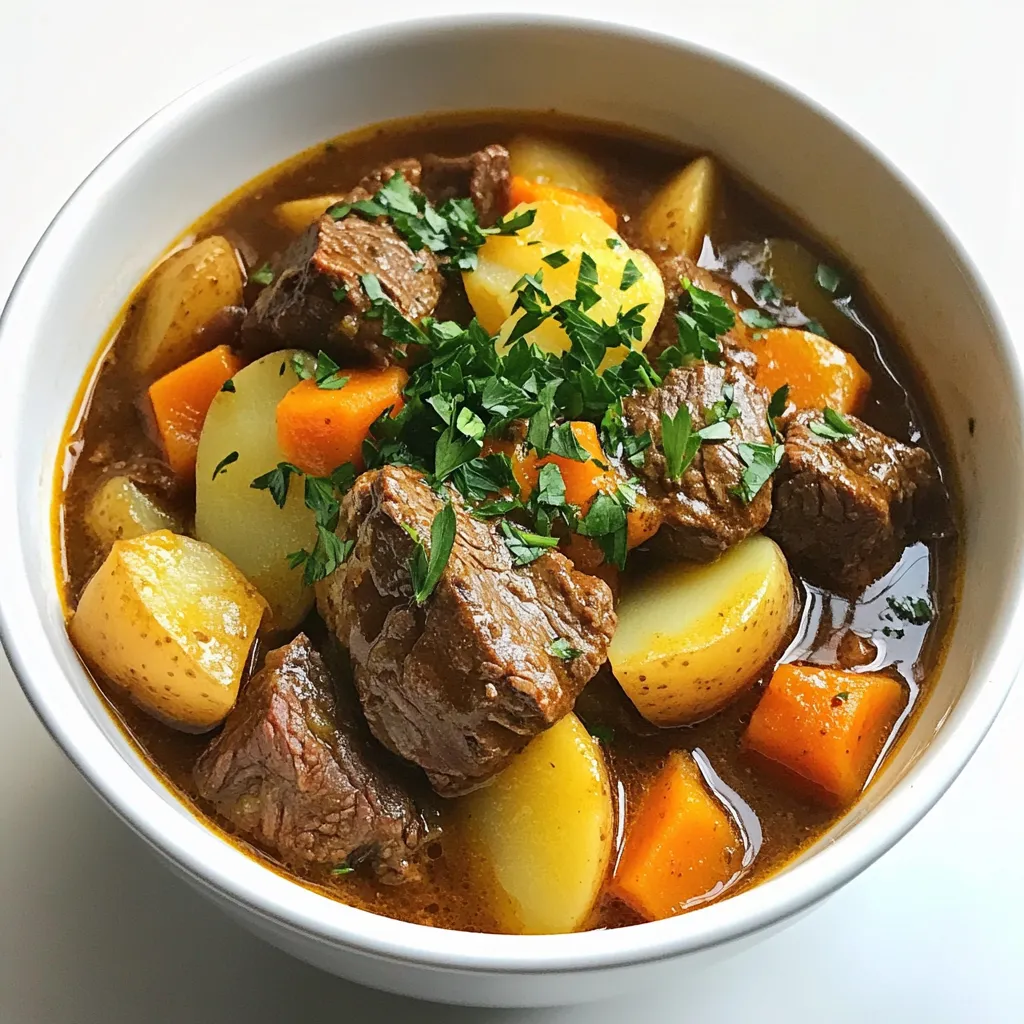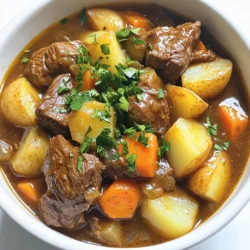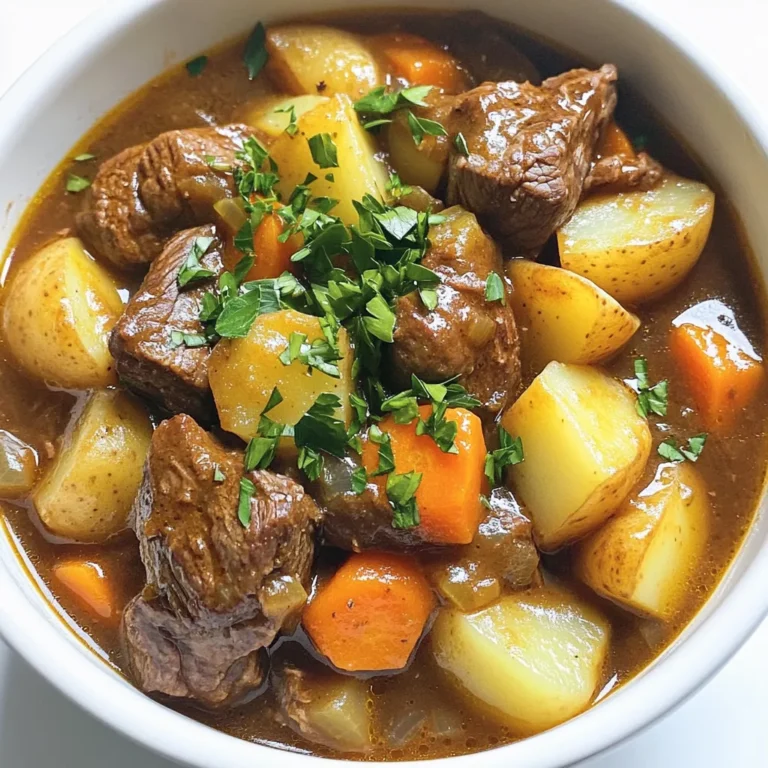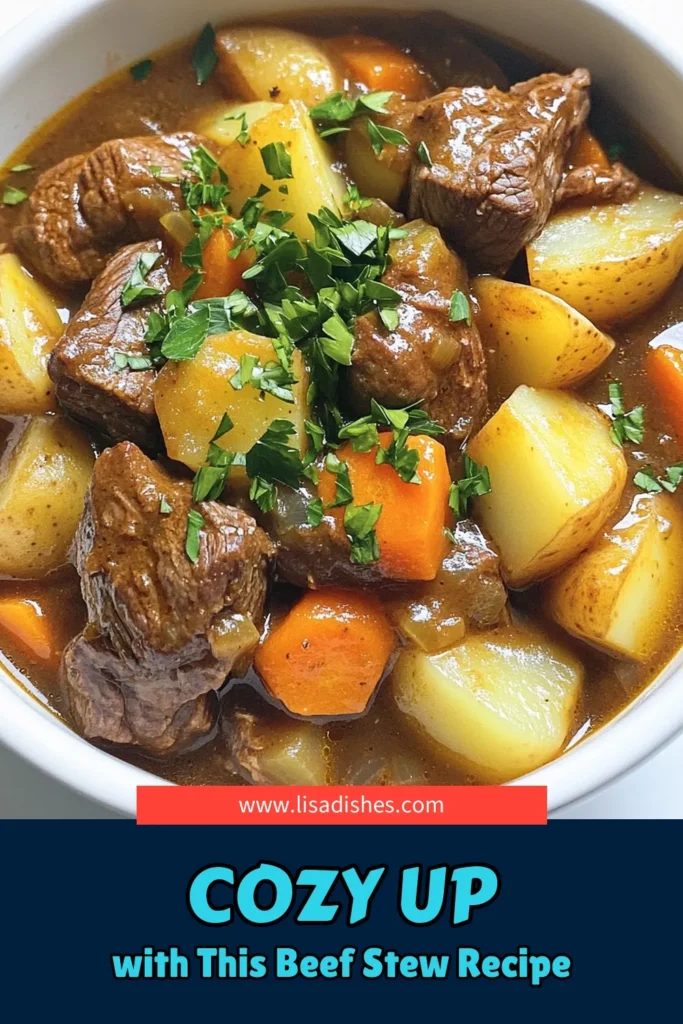Looking for a warm, cozy meal that feels like a hug in a bowl? My Slow Cooker Rustic Beef Stew is just the answer. Packed with tender beef, fresh veggies, and rich herbs, this recipe brings comfort to any table. It’s simple to make, perfect for busy days, and full of flavor. Let’s dive into how you can create this heartwarming dish effortlessly!
Ingredients
Main Ingredients
– 2 lbs beef chuck, cut into 1-inch cubes
– 4 medium potatoes, diced
– 3 carrots, sliced
– 1 large onion, chopped
– 4 cloves garlic, minced
– 1 bay leaf
Beef chuck is a great choice for stews. It becomes tender and flavorful after cooking for hours. Cut it into 1-inch cubes for even cooking. The potatoes add a hearty touch. Dice them into small chunks. Carrots bring sweetness, and the onion adds depth. Minced garlic boosts the flavor. Lastly, don’t forget the bay leaf; it adds a subtle aroma.
Seasonings & Sauces
– 3 cups beef broth (low-sodium)
– 2 tablespoons tomato paste
– 2 tablespoons Worcestershire sauce
– 1 teaspoon dried thyme
– 1 teaspoon dried rosemary
– Salt and pepper to taste
– 2 tablespoons olive oil
The beef broth serves as the stew’s base. Choose low-sodium to control salt levels. Tomato paste adds richness; it deepens the color and flavor. Worcestershire sauce gives a nice umami kick. Dried thyme and rosemary bring earthy notes. Season with salt and pepper to balance the flavors. Olive oil helps to sear the beef and enhance the taste.
Optional Garnishes
– Fresh parsley, chopped (for garnish)
Fresh parsley brightens up the dish. It adds a pop of color and a fresh taste. Sprinkle it on top just before serving. It makes the stew look inviting and adds a touch of freshness.
Step-by-Step Instructions
Preparing the Beef
– Searing the Beef
First, heat olive oil in a large skillet over medium-high heat. Once hot, add the beef cubes. Sear them until they are browned on all sides. This takes about 4 to 5 minutes. The browning adds deep flavor to the stew.
– Transferring to the Slow Cooker
After searing, transfer the beef into your slow cooker. Be careful not to lose any juices. These juices help create a rich taste in the stew.
Cooking the Vegetables
– Sautéing Onions and Garlic
In the same skillet, add chopped onions and minced garlic. Sauté them until the onions turn translucent, about 3 minutes. This step builds more flavor for the stew.
– Adding Vegetables to Slow Cooker
Next, add diced potatoes, sliced carrots, and the sautéed onion and garlic to the slow cooker. These vegetables will soak up the flavors as they cook.
Combining Ingredients
– Mixing Broth and Sauces
In a bowl, mix together the beef broth, tomato paste, and Worcestershire sauce. Stir until well combined. This mixture will give your stew a hearty base.
– Gentle Stirring Before Cooking
Pour this mixture over the ingredients in the slow cooker. Then, stir everything gently. Make sure all the ingredients are submerged in the broth to cook evenly.
Cooking Time
– Low vs. High Cooking Duration
Cover your slow cooker. You can cook on low for 8 hours or on high for 4 hours. Choose based on your schedule. Low cooking gives better flavor, while high cooking is quicker.
– Checking for Doneness
When the time is up, check the beef. It should be tender and easy to shred with a fork. If it’s not tender, let it cook a bit longer. Enjoy your delicious rustic beef stew!
Tips & Tricks
Enhancing Flavor
Alternative Seasonings
You can change the flavor by using different herbs. Try adding basil or oregano. These herbs bring a fresh taste to your beef stew. If you like spice, a pinch of red pepper flakes works well too. You can also use a splash of red wine for richness.
Tips for Searing Meat
Searing your beef adds color and flavor. Heat your skillet well before adding the olive oil. Make sure to brown all sides of the meat. This process takes about 4-5 minutes. Don’t crowd the pan; work in batches if needed. This step makes your stew more tasty.
Perfecting Texture
How to Ensure Tender Vegetables
For soft veggies, cut them into even pieces. This way, they cook at the same rate. Add root vegetables like carrots and potatoes early. They need more time to soften. Stir gently during cooking to keep them intact.
Adjusting Liquid Levels
If your stew is too thick, add more broth. Start with half a cup. Mix well and check the texture. If it’s too watery, let it cook longer with the lid off. This helps to reduce the liquid.
Serving Suggestions
Pairing with Bread or Salad
Serve your stew with crusty bread. It’s perfect for soaking up the broth. A fresh salad on the side adds lightness. Consider a simple green salad with a squeeze of lemon.
Suggested Side Dishes
Roasted vegetables or creamy mashed potatoes go great with stew. They add extra flavor and comfort. You can also serve it with a side of rice for a filling meal.

Variations
Ingredient Swaps
You can switch up the meat in this stew. If you want a change, use pork or chicken instead of beef. Both options work well with the same spices and broth. Just remember to adjust cooking times. Chicken cooks faster than beef.
For veggies, you can add or swap in peas or mushrooms. These add great flavor and texture. You can even use sweet potatoes for a sweeter touch. Don’t be afraid to mix and match what you have in your pantry.
Cooking Styles
If you prefer not to use a slow cooker, you can make this stew on the stove. Start by browning the meat in a large pot. Then, add the veggies and broth. Let it simmer for about 1.5 to 2 hours. Stir often to keep it from sticking, and check for doneness.
Another quick option is using an Instant Pot. After browning the meat, add all the ingredients, and seal the lid. Cook on high pressure for about 35 minutes. Let the steam release naturally for best results.
Dietary Modifications
For those looking to make it gluten-free, use gluten-free broth and check sauces for gluten content. Most beef broth is gluten-free, but always double-check the label.
If you’re watching sodium, use low-sodium broth and skip added salt. This will still give you a tasty stew without too much salt. You can also try fresh herbs for flavor instead of salt.
Storage Info
Storing Leftovers
– Cooling and Packaging: After serving, let the stew cool. This step helps keep it safe. Once cool, transfer it to storage containers. Use shallow containers for faster cooling.
– Best Containers for Storage: Choose airtight containers to keep the stew fresh. Glass or plastic containers work well. Label them with the date for easy tracking.
Reheating Tips
– Microwave vs. Stovetop: You can reheat the stew in the microwave or on the stovetop. For the microwave, use a microwave-safe bowl. Stir halfway through to heat evenly. On the stovetop, warm it gently over medium heat.
– Avoiding Overcooking the Beef: When reheating, keep an eye on the beef. Heat just until warm to prevent it from becoming tough. Stir gently to avoid breaking apart the meat.
Freezing Instructions
– How to Freeze Stew Properly: To freeze, let the stew cool completely. Then, pour it into freezer-safe bags. Remove as much air as possible before sealing. This helps prevent freezer burn.
– Thawing and Reheating Frozen Stew: To thaw, place the bag in the fridge overnight. For quicker thawing, submerge the bag in cold water. Reheat using the stovetop or microwave, stirring frequently to keep it moist.
FAQs
How long does it take to cook Slow Cooker Rustic Beef Stew?
Cooking this stew can take either 8 hours on low or 4 hours on high. I recommend using the low setting for best flavors. This slow method allows the beef to get tender and soak up all the tasty spices.
Can I add other vegetables to the stew?
Yes, you can add many other vegetables. Common choices include peas, green beans, or even corn. You can also swap potatoes for sweet potatoes. Feel free to use what you like or have on hand!
How do I thicken the stew if it’s too watery?
If your stew is too thin, there are a few easy ways to thicken it. You can mix a tablespoon of cornstarch with water and stir it in. Another way is to mash a few potato pieces and mix them back in. Both methods work well!
Is it safe to leave stew in a slow cooker overnight?
It is not safe to leave stew on the warm setting overnight. Always turn off the slow cooker after cooking. If you want to cook overnight, use the low setting and make sure to eat it soon after.
This blog post covered all you need to make a great Slow Cooker Rustic Beef Stew. We discussed key ingredients like beef chuck, vegetables, and seasonings. I shared step-by-step instructions, tips for flavor and texture, and even variations to suit your taste. Remember, a little experimentation can lead to your best stew yet. Follow these guidelines for a comforting dish you can enjoy any day of the week. Enjoy your cooking, and may your stew come out perfect every time!



